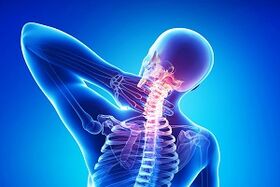Osteonecrosis is a disease caused by degeneration of cartilage tissue.In most cases, stable functioning of the intervertebral discs is noted, so they often talk about osteochondrosis of the spine.
Pathogenesis
First of all, osteoarthritis is associated with a person being in an upright position for a long time, which causes an increase in the load on the spine and intervertebral discs.
With age, the function of blood vessels decreases, the diet becomes less balanced, the body ages, which only accelerates the development of pathological processes.

Osteonecrosis is a multifactorial disease;The main prerequisites for its development may be:
- work that involves vibration or in which the body's posture frequently changes (flexion-extension, turning, bending, jerky movements);
- lifting weights;
- overweight;
- multiple pregnancy;
- lack of vitamins in the body;
- sedentary lifestyle;
- sleep on a soft mattress;
- poor posture (scoliosis);
- Vertebral instability.
Exacerbation of dystrophic disc destruction may be associated with intense physical activity (especially without warm-up), trauma, or bone pathology that changes the load distribution on the spine.
Characteristic signs of pathology
Numbness and pain, which are the main manifestations of osteoarthritis, can be observed throughout the body or only in the back.The pain increases with sudden movements, physical activity, and in some cases with sneezing or coughing.The body's attempt to protect itself from pain leads to increased muscle tension and limited mobility.
If a person does not get help and does not start treatment, the pain becomes more intense, spreading to the limbs and limiting their mobility.When the cervical thoracic spine is affected, the arms are also affected, and the lumbar spine is also affected by the lower limbs.
Symptoms vary depending on which part of the spine is affected.
Types and symptoms of osteoarthritis
Pathology can affect different parts of the spine.Taking into account the local location, cartilage degeneration can develop in the cervical region (more than 25% of diagnosed cases), lumbar region (more than 50%) or thoracic region (12%).
Exacerbation of dystrophic disc destruction may be associated with intense physical activity (especially without warm-up), trauma, or bone pathology that changes the load distribution on the spine.
Neck bone necrosis
The spinal cord, arteries (which supply blood to the brain), nerve trunks and roots (which create nerve connections with the arms, lungs and heart) pass through the neck area.Over the years, especially for people who are untrained or work in front of a computer for long periods of time, neck movement becomes difficult.
Typical symptoms of cervical spondylosis:
- headaches and heart attacks;
- dizziness (possible short-term loss of consciousness, associated with impaired blood supply to the brain);
- numbness and pain in the shoulder or arm joint.
Osteonecrosis of the chest area

Pain in the chest area is familiar to people who regularly and long-term do manual labor, people who work in "sedentary" occupations (architects, designers, drivers).
Main symptoms of osteoarthritis in the chest area:
- feeling like being "stuck in the chest";
- feeling of pain in the neck area, between the shoulder blades;
- hand numbness (temporary, long-term);
- hearing and vision impairment;
- increased sweating;
- headache spreading to the back of the head (usually lasting, up to 12 hours);
- changes in blood pressure and intracranial pressure;
- tachycardia and arrhythmia.
A good way to prevent osteochondrosis in the chest is correct posture.
Symptoms of lumbar osteoarthritis
Health problems caused by osteoarthritis in the lumbar region are as follows:
- frequent urination;
- numbness of limbs;
- dizzy;
- muscle spasms and cramps;
- difficulty moving, bending, and rotating the body;
- the development of scoliosis;
- back pain, especially in the morning, immediately after waking up;
- decreased muscle sensitivity and tone.
The pain and its intensity reach their peak during the acute phase of the disease.Their duration may cause a person discomfort for a few days, but sometimes the pain lasts for weeks or even months.As the pathological process in the intervertebral disc progresses, the severity of symptoms decreases.After 60 years, the disease becomes chronic and the pain disappears.
Stages of the disease
Osteonecrosis is a progressive disease, the transition to each subsequent form occurs gradually.One of the stages is hernia formation, which occurs when the annulus fibrosus thins.When ruptured, protrusion of the nucleus occurs, compressing the roots, leading to more pain and reducing the disc's ability to absorb shock.
The main stages of development of osteoarthritis:
- A person develops characteristic complaints due to exertion or being in a prolonged position.X-rays show that the space between the vertebrae is slightly narrowed.
- The disc becomes unstable, the cartilage tissue spreads into the fibrous ring, and the nerve roots are compressed.X-rays show a decrease in the distance between the vertebrae, displacement of the vertebrae and proliferation of bone tissue.
- Intervertebral hernia develops.The disc moves more and more into the surrounding tissue.Violation causes damage to nerves and blood vessels.The pain is increasing, there is a feeling of numbness and limited movement of the limbs.
- The disc hardens and is replaced by scar tissue.With fibrosis, the bones protrude along the edges and the distance between the vertebrae is significantly reduced.The mobility of the spine decreases and appears to stiffen.
Diagnosis of osteoarthritis
A preliminary diagnosis is made by the doctor based on the patient's complaints and after a visual examination.Pain and tenderness at certain points, state of muscle tone, range of motion, and presence of postural disorders (eg, signs of scoliosis) are all taken into account.
The presence of osteonecrosis and its stage were clarified after instrumental research methods were implemented.First, the doctor will order an X-ray of the spine area of concern.
After studying the images, the expert determined:
- Whether the distance between vertebrae is reduced or not;
- Whether the cartilage tissue is depleted or not;
- At what stage is the pathological process taking place?
If an intervertebral hernia is detected in the patient, an MRI scan will be indicated.Using layer-by-layer scanning and soft tissue visualization, a preliminary diagnosis can be confirmed or refuted with high accuracy.
How to treat osteoarthritis
Treatment of the disease is long-term, the main goal is to reduce pain and muscle tension, and after determining the cause of the disease, prevent the development of the pathological process.
The specialist decides which treatment will be most effective, based on the results of the research and the severity of the pathology at hand.progress.
Treatment of osteoarthritis with medication

The main goal of this type of disease is to stop inflammation and pain, while reducing muscle spasms.This can be done by giving the patient:
- Nonsteroidal anti-inflammatory drugs.To reduce skeletal muscle tone, muscle spasms and nerve root compression, specialists supplement muscle relaxants with NSAIDs.
- B vitamin preparations.
The optimal treatment duration is 7-10 days.
Medications are often supplemented with topical treatments.Warming ointments or gels containing NSAIDs can be applied to the affected area, which helps increase blood supply, metabolism and suppress inflammation.External treatment measures quickly relieve pain because the main active ingredient penetrates into the inflamed area and immediately begins to "act".
Medication is often supplemented with exercise therapy, massage, physical acupressure, or manual therapy.
The main task of people with osteoarthritis is to reduce the frequency and severity of pain symptoms (especially during exacerbations).Compliance with the doctor's recommendations and the use of medication in combination with physiotherapy exercises will help restore normal function of the spine and avoid the need for surgical intervention.















































